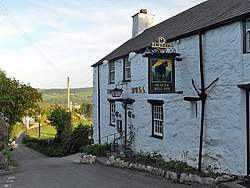Llanbedr-y-Cennin
| Llanbedr-y-Cennin | |
| Caernarfonshire | |
|---|---|
 Ye Olde Bull Inn public house, Llanbedr-y-Cennin | |
| Location | |
| Grid reference: | SH763692 |
| Location: | 53°12’22"N, 3°51’7"W |
| Data | |
| Post town: | Conwy |
| Postcode: | LL32 |
| Dialling code: | 01492 |
| Local Government | |
| Council: | Conwy |
| Parliamentary constituency: |
Aberconwy |
Llanbedr-y-Cennin is a small village and ancient parish in the Isaf hundred of Caernarfonshire. It forms part of the civil community of Caerhun.
It lies in the foothills on the western side of the Conwy valley. The river Conwy runs through the valley, running into the sea to the north, at the town of Conwy, which is about five miles north of the village. The village lies on the eastern edge of the Snowdonia National Park. Near the village lies the Iron Age fort of Pen y Gaer.
In recent years the village has become popular with ornithologists as one of the best places in Wales to observe rare hawfinches. They feed adjacent to the churchyard, attracting many bird watchers in early spring.[1][2]
Name of the village

"Llanbedr" means St Peter's church in Welsh, while Cennin can refer to leeks or to daffodils, the latter being "Cennin Pedr" (St Peter's leeks) in Welsh.
Historical background
The village grew out of a mainly pastoral industry (mostly sheep farming and dairy produce). It has a parish church (Anglican), a Nonconformist chapel (Independent), and a local pub (Ye Olde Bull Inn) which served J.W. Lees real ale (from a Manchester brewery). In the 1960s, the village's only shop used to be a bakery and post office also, but the post office has been discontinued. The public house closed its doors to the public as a J.W. Lees owned pub for the last time in May 2018. On the 27 September 2019 the pub re-opened as a Free house.[3]
An ancient well at Llanbedr-y-Cennin, Ffyonnen Bedr (‘Peter’s Well’) was believed to have healing powers.[4]
Artists' Colony
The latter 19th century saw a number of artists living in Llanbedr-y-cennin and neighbouring Tal-y-bont. The art movement, which had started in Betws-y-coed in the 1850s, saw a movement down the valley after the arrival of the railway in Betws-y-coed. Initial settlement was in Trefriw, and the 1871 census listed the first artist settler in Llanbedr/Tal-y-bont as J.Cole. There were 7 artists living here by the 1881 census, and 15 by 1891.[5]
Charles Potter, an artist from Oldham (many of the artists were originally from the Manchester area), was instrumental in setting up the Tal-y-bont Artists Club, and in raising funds to construct in 1886 the ‘Artists Club’ building at Tal-y-bont (actually Llandbedr-y-cennin), and he became its first President. The group had originally starting meeting informally at the Olde Bull Inn in 1883, then in 1884 used the upper floor of a stable building (above a carpenter's workshop, and now demolished) as their first studio.
Named “Walden”, the building offered a studio, a gallery, a classroom, a billiard room, and entertainment space. It originally had 40 members, male artists who lived or worked locally, although there were 150 honorary members. It had a committee of 17 members. The building was also used to hold art courses for clubs from far-and-wide, and every autumn there was an exhibition, despite the fact that this was not an altogether accessible place to the average picture-buying tourist. Nevertheless, membership (including non-resident members) grew to a number approaching 150.
The artist colony was a strong influence on the formation of the Royal Cambrian Academy of Art, which moved into Plas Mawr in 1886.
The colony came to an end at the onset of World War I, and in the 1920s the building became a private home.[6]
A number of artists are buried in the churchyard at Llanbedr.
Points of note
- Snowdonia National Park: In the hills to the west above and beyond the village are roads and hillwalking tracks giving access to the hills and lakes of the Snowdonia National Park. This is the main route of access to Llyn Eigiau.
Parish rectors
Notable rectors of the parish include:
- 1719–1735: John Ellis – also vicar for Caerhun and buried in the parish[7]
- 1802–1826: John Williams – also vicar for Caerhun and buried in the parish[8]
References
- ↑ Daily Post - Bird notes
- ↑ The Biggest Twitch
- ↑ "One of Wales's oldest pubs to reopen after being bought by chef who first worked there as a teenager". 25 August 2019. https://www.dailypost.co.uk/business/business-news/one-waless-oldest-pubs-reopen-16812880.
- ↑ "Rediscovering the Lines Family - Exhibition catalogue". Royal Birmingham Society of Artists. 2009. http://www.rbsa.org.uk/content/repository/download/201206121446514910/201206121446514910.pdf. Retrieved 27 January 2013.
- ↑ Artists in the Conwy Valley, by T. Ellis, 2010
- ↑ The Betws-y-coed Artists' Colony, 1844-1914, by Peter Lord, Coast & Country, 1998, 2009.
- ↑ "Williams, John (1760–1826), cleric and schoolmaster". Dictionary of Welsh Biography. https://biography.wales/article/s-WILL-JOH-1760.
- ↑ "Ellis, John (1674–1735), cleric and antiquary". Dictionary of Welsh Biography. https://biography.wales/article/s-ELLI-JOH-1674.
Outside links
| ("Wikimedia Commons" has material about Llanbedr-y-Cennin) |
